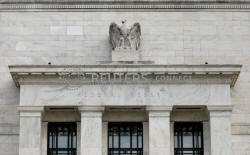Analysis: U.S. bill rates risk going negative, but stimulus could change
the course
 Send a link to a friend
Send a link to a friend
 [February 23, 2021] By
Karen Brettell [February 23, 2021] By
Karen Brettell
(Reuters) - Short-dated U.S. Treasury debt
yields risk turning negative as the U.S. government curbs sales of
Treasury bills, but analysts are looking at the progress of the stimulus
bill to assess whether any dip in yields could be a temporary issue.
Bill yields last turned negative in March 2020 amid market turmoil
prompted by the pandemic spreading to the United States. If borrowing
rates fall too far it could disrupt key funding markets and hurt the
almost $5 trillion money market fund industry, making funds hesitant to
accept new investments.
The U.S. Treasury Department, slashing its cash balance after amassing
liquidity to pay for fiscal stimulus, which was delayed, said earlier
this month it plans to cut its cash balance to $500 billion in June,
from $1.7 trillion at year-end. That could pressure bills - U.S.
government debt issues with maturities of one year or less - into
negative territory.

But those projections do not account for new fiscal spending and if the
Biden administration passes a larger bill than expected, and one that
necessitates a lot of cash out the door fast, then cuts to bill issuance
- and possible negative yields - may not prove lasting.
"If we do get a large package, call it in the next month, then bill
supply is going to need to ramp up at least for the short term," said
Zachary Griffiths, a macro strategist at Wells Fargo in Charlotte.
(Graphic: Treasury bill yields,
https://fingfx.thomsonreuters.com/
gfx/mkt/rlgpdealnvo/BillYields.PNG)
"The Treasury still has a huge cash balance that they can rely on but it
will also need to keep bill supply positive in the near term to help
finance that and smooth things through from a supply perspective," he
said.
The U.S. House of Representatives Budget Committee on Monday approved
legislation with $1.9 trillion in new coronavirus relief, advancing a
top priority of President Joe Biden.The full House, which has a slim
Democratic majority, hopes to pass the bill later this week.
One-month, three-month and six-month yields were at 2-to-4 basis points
on Monday.
If yields do turn negative for any significant length of time the
Federal Reserve may need to intervene and increase the interest it pays
on excess reserves (IOER), Griffiths said.
The Fed has relied on tweaks to IOER, which is what it pays banks for
reserve balances, and to rates in its overnight reverse repurchase
agreement (repo) facility in the past to keep the fed funds rate inside
of its target band. That is currently zero to 25 basis points.
Raising these rates can lure more cash away from other lending markets,
and ease the downward pressure on short-term rates.
[to top of second column] |

The Federal Reserve building is pictured in Washington, DC, U.S.,
August 22, 2018. REUTERS/Chris Wattie/File Photo

The Treasury cannot sell bills with negative rates, but they have traded in
negative territory in the secondary markets during times of stress and when
demand for safe assets has outstripped supply.
Blake Gwinn, a rates strategist at NatWest Markets, said the Fed is unlikely to
act on negative bill rates unless they persist for a long-time.
A larger risk, he said, is if the fed funds rate, which was 7 basis points on
Friday, dips below the 5 basis-point area, which would likely prompt the Fed to
act.
The fed funds market is dominated by Government-Sponsored Enterprises (GSEs)
such as Fannie Mae, Freddie Mac and the Federal Home Loan Bank System. If this
rate falls to 2 or 3 basis points, they may prefer to park cash with the Fed,
which would leave the market very illiquid and prone to large swings in
borrowing rates, Gwinn said.
The likelihood of Fed action may also depend on monthly investment patterns of
GSEs, which each month temporarily park principal and interest from
mortgage-backed securities (MBS) in repo, before pulling it out to pay the
owners of the MBS.
That temporarily pulls down the repo rate, which can in turn send fed funds
lower.
Overnight repo rates fell as low as zero on Thursday, and were five basis points
on Monday.
The Fed has indicated it is aware of the issue, noting in recent minutes
https://www.federalreserve.gov/
monetarypolicy/files/
fomcminutes20210127.pdf an expected decline in the federal funds rate in the
second quarter, but has not expressed near-term concern.

Any hike to IOER would be a technical adjustment and would not indicate a move
away from the Fed's commitment to rock-bottom rates for some time to come.
“They’re clearly monitoring the situation because they’re talking about it but
they’re also not expecting that it’s going to be a near-term event they have to
deal with,” said Tom Simons, a money market economist at Jefferies in New York.
(Graphic: Fed funds and repo rates,
https://fingfx.thomsonreuters.com/
gfx/mkt/xlbpgdzoovq/
Fed%20funds.PNG)
(Reporting by Karen Brettell in New York; Editing by Megan Davies, Dan Burns and
Matthew Lewis)
[© 2021 Thomson Reuters. All rights
reserved.] Copyright 2021 Reuters. All rights reserved. This material may not be published,
broadcast, rewritten or redistributed.
Thompson Reuters is solely responsible for this content. |